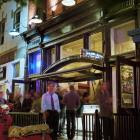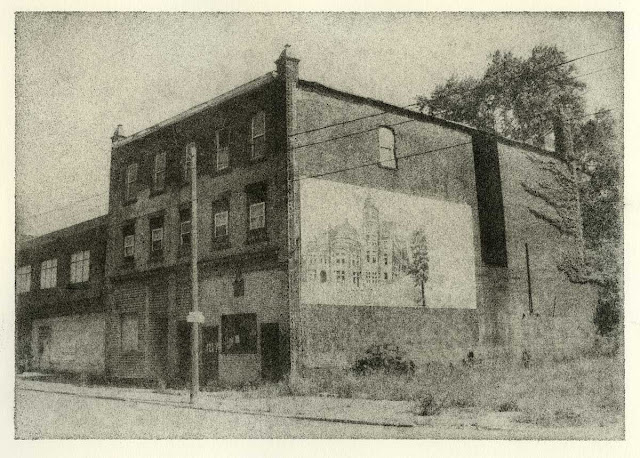Photo Gathering for Large Format & Alternative Processes
Online resource for information about Photogathering photographers and the monthly meetings held in metropolitan Washington, D.C.
Followers
8.04.2012
6.22.2012
Photographers At Artomatic - Closing June 23, 2012
Artomatic in Crystal City, Arlington, Virginia, will close this Saturday night, June 23, 2012. With it closes our famous Camera Obscura Installation (day viewing only) and the exhibits by 5 of our group members.
Press:
Individual Exhibits and Site Links:
Barry Schmetter
Carole Hollander
George L. Smyth
Joanna Knox Yoder
Scott Davis
Press:
- John Anderson Artomatic: Out of Vitamins Washington City Paper
- George Smyth, Artomatic Camera Obscura f/295 Pinhole Forum
- Michael O'Sullivan, Artomatic Returns to Crystal City Washington Post
- Mark Jenkins, Galleries: Artomatic Entertainment, Washington Post
- Smithsonian Studio Arts Blog Real-Life Camera Obscura
- Tammy Vitale (blog), Artomatic Interview #14 Joanna Knox Yoder
Individual Exhibits and Site Links:
Barry Schmetter
 |
| Tube, pigment ink print |
Carole Hollander
 |
| Last Look, silver gelatin print - Dad Remains, cremains print |
George L. Smyth
 |
| Braddock Project (part of), bromoil |
Joanna Knox Yoder
 |
| Skeleton Key, tintype |
Scott Davis
 |
| Pearl Dive Vespa, pigment print |
5.20.2012
Camera Obscura at Artomatic
The camera obscura is an optical device that projects an image of its surroundings on a screen. It is used in drawing and for entertainment, and was one of the inventions that led to photography. The device consists of a box or room with a hole in one side. Light from an external scene passes through the hole and strikes a surface inside where it is reproduced, upside-down, but with color and perspective preserved.
 |
| Camera Obscura at Artomatic 2012, photo by David Struewing |
Members of The Photo Gathering created a Camera Obscura using a room at Artomatic 2012 in Crystal City, Arlington, VirginIA. The walls were painted black and the windows covered with black opaque paper with a small hole for a meniscus lens. Light passes through the lens, and the scene outside the window, National Airport and The Potomac River, is projected onto the opposite wall and ceiling (painted white). The live image is upside down and backwards (most is on the ceiling).
 |
image Library of Congress The Camera Obscura will be at Artomatic (free) during daylight hours through June 23, 2012 Wednesdays and Thursdays: noon – 10 pm Fridays and Saturdays: noon – 1 amSundays: noon – 5 pmClosed Mondays and TuesdaysArtomatic Site and Directions |
4.06.2012
Bromoil Demonstration May 3, 2012 by George L. Smyth
The one sentence explanation of how to make a Bromoil print is that the silver that forms the image in a traditional darkroom print is removed and replaced with lithographic ink by striking it repeatedly with an ink-charged brush. Of course there is more to it, as will be demonstrated by George L Smyth on 3 May. George has given talks and workshops on the Bromoil process and an example of his work can be found at http://GeorgeSmyth.com. George Smyth's work will be showcased at The Glenview Mansion Art Gallery in Rockville, Maryland June, 2012. Glenview Mansion June 2012 Exhibit  |
| Please Do Not Sit Here |
 |
| Welcome Home |
3.19.2012
Pinhole Demonstration April 5, 2012
Joshua Dunn will demonstrate and the pinhole camera and it's many variations.
George L. Smyth will display prints from the sieve pinhole variation.
Following the presentations there will be a gear swap and print sharing.
http://www.pinholeday.org/support/?pid=faq by Larry Bullis
Pinhole photography is similar to "common photography" in most respects but differs in that the camera used has no lens. Instead, it has a very small aperture which projects an image upon the sensitized material (film or paper). This necessitates different ways of working (primarily because the exposures must be relatively long) and produces images which differ from lens images in several important respects.

Information and Links:
Worldwide Pinhole Day is April 29, 2012 (the last Sunday in April)
http://www.pinholeday.org/org/
Wiki on Pinhole:
http://en.wikipedia.org/wiki/Pinhole_camera
George L. Smyth will display prints from the sieve pinhole variation.
Following the presentations there will be a gear swap and print sharing.
http://www.pinholeday.org/support/?pid=faq by Larry Bullis
Pinhole photography is similar to "common photography" in most respects but differs in that the camera used has no lens. Instead, it has a very small aperture which projects an image upon the sensitized material (film or paper). This necessitates different ways of working (primarily because the exposures must be relatively long) and produces images which differ from lens images in several important respects.
Where a lens forms an image by bringing rays of light coming to it from each point in the subject to a common focus, the pinhole does not focus at all. Instead, it acts as a center of projection.
Speaking practically, a ray of light from any point in the subject, passing through the pinhole, will intersect the film in only one place. Another ray of light, coming from a different point in the subject and passing through the hole will strike the film in a different place. The accumulation of all rays of light passing through the hole will thus form an image at the film plane. If the film plane were moved forward or backward, the image would still be there, but it would be smaller or larger depending upon where it were located.
Because the hole is actually not truly a point, it allows more than just one ray from each point in the subject to strike the film. We could say that it passes a small bundle of rays from each point. This is one reason why pinhole images are characteristically softer than lens images. The other reason is that some of the rays encounter the edge of the hole and are diffracted; they bend.
Since there is no focus, the sharpness of the image (such as it is; it is always somewhat "soft") is uniform from near distance to far. In other words, there is no limitation of depth of field as there is in lens photography. Very near objects (closer than the pinhole to film distance) will however become softer due to divergence of the rays coming from each point.
Information and Links:
Worldwide Pinhole Day is April 29, 2012 (the last Sunday in April)
http://www.pinholeday.org/org/
Wiki on Pinhole:
http://en.wikipedia.org/wiki/Pinhole_camera
2.16.2012
Wet Plate Demonstration March 1
Photographers Barry Schmetter and Joshua Dunn will be demonstrating the wet plate process.
There will be a small charge for plates made during this demonstration. No charge for attending.
Space may be limited. Kindly RSVP to largeformatgathering@gmail.com.
Links for wet plate information:
Scully & Osterman
Wikipedia Collodion Process
There will be a small charge for plates made during this demonstration. No charge for attending.
Space may be limited. Kindly RSVP to largeformatgathering@gmail.com.
Links for wet plate information:
Scully & Osterman
Wikipedia Collodion Process
 |
| George Smyth, Victorian banker Copyright George Smyth 2010 |
 |
| Skull In Cabinet Copyright Barry Schmetter 2011 |
 |
| Window Still Life Copyright Barry Schmetter 2012 |
2.11.2012
Fifth Year and New Location at VisArts At Rockville
This month Photo Gathering for Large Format and Alternative Processes will begin it's fifth year. Our new location will be at VisArts At Rockville on the 3rd floor in the photography suite.
Subscribe to:
Comments (Atom)